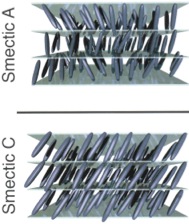Liquid Crystalline Soft Matter
The de Vries tilting transition in smectic liquid crystals
The most interesting smectic phase for application in electrooptic devices, e.g. in very fast and ultrahigh resolution liquid crystal displays, is the chiral smectic-C phase and its variations. As in all smectics the molecules organize into layers but the characteristic of this class of smectics is that the molecules tilt uniformly within the layers away from the smectic layer normal. This reduction of symmetry, together with the removal of mirror planes that chirality ensures, allows the appearance of a spontaneous polarization and this allows the molecules to be very rapidly switched between different states with an electric field, where the sign of the field determines the direction of rearrangement (in contrast to standard nematic displays which are insensitive to the sign of the field).
A critical problem in realizing commercial devices utilizing such materials is however the shrinkage of the smectic layers that normally occurs at the transition between the SmA phase, in which the molecules are not uniformly tilted, and the SmC phase or one of its variations. This geometric change gives rise to serious defects in the smectic structure which lead to light scattering and a general reduction in device performance. A possible way to resolve this problem is to use materials that exhibit a tilting transition of an unusual type, possibly connected to the SmA phase being unusual as well, where the tilt arises more as a consequence of the tilting directions of many molecules becoming identical, rather than an actual increase of tilt. Such a transition does not change the layer thickness and therefore the defects can largely be avoided. This type of tilting transition is still relatively unusual and the exact mechanisms behind it are still a matter of discussion.
In particular during his Ph.D. and post-doc research Prof. Lagerwall worked intensely on this topic but still today he shows a keen interest in this fascinating issue. A detailed introduction to the field can be found in Prof. Lagerwall’s Ph.D. thesis and some key journal publications on the topic are the following:
- Current topics in smectic liquid crystal research (Review article)
Jan P. F. Lagerwall, Frank Giesselmann
ChemPhysChem, 7, 1, pp. 20-45 (2006) - Effects of chain branching and chirality on liquid crystalline phases of bent-core molecules:
blue phases, de Vries transitions and switching of diastereomeric states
Hale Ocak, Belkiz Bilgin-Eran, Marko Prehm, Stefan Schymura, Jan P. F. Lagerwall and Carsten Tschierske
Soft Matter, 7, 18, pp. 8266 - 8280 (2011) - Molecular model for de Vries type smectic-A–smectic-C phase transition in liquid crystals
M. V. Gorkunov, F. Giesselman, J. P. F. Lagerwall, T. J. Sluckin and M. A. Osipov
Phys. Rev. E, 75, 060701(R) (2007) - The peculiar optic, dielectric and x-ray diffraction properties of a fluorinated de Vries asymmetric-diffuse-cone-model ferroelectric liquid crystal
This paper was the second most downloaded article in the 2006 volume of the journal ‘Liquid Crystals’, as of 18.5.2007.
Jan P. F. Lagerwall, David Coleman, Eva Körblova, Chris Jones, Renfan Shao, José M. Otón, David M. Walba, Noel A. Clark, Frank Giesselmann
Liq. Cryst. 33, 1, pp. 17-24 (2006) - Antiferroelectric liquid crystal mixture without smectic layer shrinkage at the direct Sm-A* - Sm-Ca * transition
Frank Gießelmann, Jan P. F. Lagerwall, Gunnar Andersson and Marc D. Radcliffe
Phys. Rev. E 66, 051704 (2002) - Optical and X-ray evidence of the de Vries Sm-A*–Sm-C* transition in a non-layer shrinkage ferroelectric liquid crystal with very weak interlayer tilt correlation
Jan P. F. Lagerwall, Frank Giesselmann, Marc Radcliffe
Phys. Rev. E, 66, 031703 (2002)
 Back to research overview map.
Back to research overview map.
